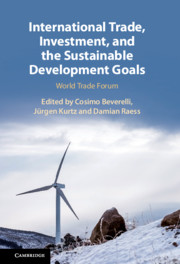Book contents
- International Trade, Investment, and the Sustainable Development Goals
- International Trade, Investment, and the Sustainable Development Goals
- Copyright page
- Contents
- Figures
- Tables
- Contributors
- Preface
- Introduction
- Part I Penetration and Diffusion of the Sustainable Development Goals
- Part II Top-Down: Public Approaches to Achieving the Sustainable Development Goals
- Part III Bottom-Up: Private Sector and Civil Society Initiatives on the Sustainable Development Goals
- 6 Voluntary Standards, Trade, and Sustainable Development
- 7 The Role of Voluntary Sustainability Standards in Sustainable Livelihoods for Cocoa Farmers in Côte d’Ivoire
- 8 Unblocking the Trade Pipes
- 9 The Effects of Environmental Costs on Public Support for Foreign Direct Investment
- Conclusion
- Index
- References
9 - The Effects of Environmental Costs on Public Support for Foreign Direct Investment
Differences Between the United States and India
from Part III - Bottom-Up: Private Sector and Civil Society Initiatives on the Sustainable Development Goals
Published online by Cambridge University Press: 18 September 2020
- International Trade, Investment, and the Sustainable Development Goals
- International Trade, Investment, and the Sustainable Development Goals
- Copyright page
- Contents
- Figures
- Tables
- Contributors
- Preface
- Introduction
- Part I Penetration and Diffusion of the Sustainable Development Goals
- Part II Top-Down: Public Approaches to Achieving the Sustainable Development Goals
- Part III Bottom-Up: Private Sector and Civil Society Initiatives on the Sustainable Development Goals
- 6 Voluntary Standards, Trade, and Sustainable Development
- 7 The Role of Voluntary Sustainability Standards in Sustainable Livelihoods for Cocoa Farmers in Côte d’Ivoire
- 8 Unblocking the Trade Pipes
- 9 The Effects of Environmental Costs on Public Support for Foreign Direct Investment
- Conclusion
- Index
- References
Summary
Is economic development a prerequisite for concern over environmental issues? The existing literature has yet to reach an empirical consensus on this question. To revisit this important topic, we offer new experimental evidence by conducting online survey experiments in one developed country (the United States) and one developing country (India). We investigate how providing information on the negative environmental costs of foreign direct investment (FDI) affects people’s support of FDI, and how these effects differ between residents of the United States and India. The results of our experiment show that among residents of the United States, being presented with information about the environmental costs of FDI sharply reduces support for FDI, while a substantially weaker effect of the environmental costs of FDI was observed among residents of India. Also, respondents from the United States are more concerned about environmental damage caused by FDI in their own city than in a distant location, while this pattern is not observed among respondents from India. These results are consistent with the claim that economic prosperity and wealth are prerequisites for environmental concern.
Keywords
- Type
- Chapter
- Information
- International Trade, Investment, and the Sustainable Development GoalsWorld Trade Forum, pp. 270 - 309Publisher: Cambridge University PressPrint publication year: 2020
References
- 2
- Cited by



